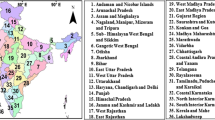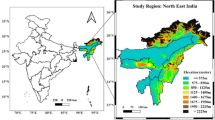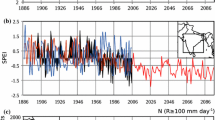Abstract
Using surface observations from 58 widely distributed stations over India, a highly significant (99.9 %) decreasing trend of pan evaporation (Epan) of 9.24 mm/a/a is calculated for 1971 to 2010. This constitutes a ~10 % reduction of Epan over the last four decades. While Epan is decreasing during the wet summer monsoon season (JJAS), as well as during the dry rest of the year, the rate of decrease during the dry season is much larger than that during the wet season. Apart from increasing solar dimming, surface winds are also persistently decreasing over the Indian sub-continent at the rate of −0.02 m/s/a resulting in ~40 % reduction over the last four decades. Based on PenPan model, it is shown that both the above factors contribute significantly to the decreasing trend in Epan. On a continental scale, annual mean potential evaporation (Ep) is larger than rainfall (P or Ep-P > 0, moisture divergence) indicating that India is water-limited. However, during wet monsoon P > Ep (or Ep-P < 0, moisture convergence) indicating that India is energy-limited during this season. Long term data shows that annually Ep-P follows a significant decreasing trend indicating that water limitation is decreasing with time. This is largely due to stronger decreasing trend of Ep-P during the dry season compared to weaker increasing trend of Ep-P during the wet monsoon season. The scatter plot of Ep-P versus Ep also conveys that the decrease in Ep leads to increase in moisture convergence in wet season and decrease in moisture divergence in dry season.





Similar content being viewed by others
Explore related subjects
Discover the latest articles and news from researchers in related subjects, suggested using machine learning.References
Bawisker SM (2009) Weakening of lower tropospheric temperature gradient between Indian landmass and neighbouring oceans and its impact on Indian monsoon. J Earth Syst Sci 118(4):273–280
Beck HE et al (2011) Global evaluation of four AVHRR-NDVI data-sets: intercomparison and assessment against Landsat imagery. Remote Sens Environ 115(10):2547–2563
Bollasina MA, Ming Y, Ramaswamy V (2011) Anthropogenic aerosols and the weakening of the south Asian summer monsoon. Sci Expr. doi:10.1126/science.1204994
Budyko MI (1974) Climate and life. International geophysics series, 18. Academic, New York, p 508
Chattopadhyay N, Hulme M (1997) Evaporation and potential evapotranspiration in India under conditions of recent and future climate change. Agric For Meteorol 87:55–73
Che HZG, Shi Y, Zhang XY, Arimoto R, Zhao JQ, Xu L, Wang B, Chen ZH (2005) Analysis of 40 years of solar radiation data from China 1961–2000. Geophys Res Lett 32, L06803. doi:10.1029/2004GL022322
Cohen SA, Ianetz A, Stanhill G (2002) Evaporative climate changes at Bet Dagan Israel 1964–1998. Agric For Meteorol 111:83–91
Collier JC, Zhang GJ (2009) Aerosol direct forcing of the summer Indian monsoon as simulated by the NCAR CAM3. Clim Dyn 32:313–332. doi:10.1007/s00382-008-0464-9
Douville H, Chauvin F, Planton S, Royer J-F, Salas-Melia D, Tyteca S (2002) Sensitivity of the hydrological cycle to increasing amounts of greenhouse gases and aerosols. Clim Dyn 20:45–68
Goswami BN, Venugopal V, Sengupta D, Madhusoodanan MS, Xavier PK (2006) Increasing trend of extreme rain events over India in a warming environment. Science 314:1442. doi:10.1126/science.1132027
Guo H, Xu M, Hub Q (2011) Changes in near-surface wind speed in China: 1969–2005. Int J Climatol 31(3):349–358
Huntington TG (2006) Evidence for intensification of the global water cycle: review and synthesis. J Hydrol 319(1–4):83–95
Jacobson MZ, Kaufman YJ (2006) Wind reduction by aerosols particles. Geophys Res Lett 33, L24814. doi:10.1029/2006GL027838
Jaswal AK, Prakasa Rao GS, De US (2008) Spatial and temporal characteristics of evaporation trends over India during 1971–2000. Mausam 59(2):149–158
Jhajharia D, Shrivastava SK, Sarkar D, Sarkar S (2009) Temporal characteristics of pan evaporation trends under the humid conditions of northeast India. Agric For Meteorol 149(5):763–770
Kaufman YJ, Tanre D, Boucher O (2002) A satellite view of aerosols in the climate system. Nature 419:215–223
Klink K (1999) Trends in monthly maximum and minimum surface wind speeds in the coterminous United States 1961 to 1990. Clim Res 13:193–205
Kothawale DR, Munot AA, Krishna Kumar K (2010) Surface air-temperature variability over India during 1901–2007 and its association with ENSO. Clim Res 42:89–104
Lau K-M, Kim K-M (2010) Fingerprinting the impacts of aerosols on long-term trends of the Indian summer monsoon regional rainfall. Geophys Res Lett 37, L16705. doi:10.1029/2010GL043255
Linacre ET (1994) Estimating U.S. Class A pan evaporation from few climate data. Water Int 19:5–14
Liu BH, Xu M, Henderson M, Gong W (2004) A spatial analysis of pan evaporation trends in China 1995–2000. J Geophys Res 109, D15102. doi:10.1029/2004JD004511
Loaiciga HA, Valdes JB, Vogel R, Garvey J (1996) Global warming and the hydrological cycle. J Hydrol 174:83–127
Lofmann U (2006) Aerosol effects on clouds and climate. Space Sci Rev 125:129–137. doi:10.1007/s11214-006-9051-8
Lu J, Deser C, Reichler T (2009) Cause of the widening of the tropical belt since 1958. Geophys Res Lett 36, L03803. doi:10.1029/2008GL036076
McVicar TR et al (2007) Spatially distributing monthly reference evapotranspiration and pan evaporation considering topographic influences. J Hydrol 338(3–4):196–220
McVicar TR, Van Niel TG, Li LT, Roderick ML, Rayner DP, Ricciardulli L, Donohue RJ (2008) Wind speed climatology and trends for Australia 1975–2006: capturing the stilling phenomenon and comparison with near-surface reanalysis output. Geophys Res Lett 35, L20403. doi:10.1029/2008GL035627
McVicar TR et al (2012) Global review and synthesis of trends in observed terrestrial near-surface wind speeds: Implications for evaporation. J Hydrol 416–417:182–205
Meehl GA, Arblaster JM, Collins WD (2008) Effect of black carbon aerosols on Indian monsoon. J Clim 21:2869–2882. doi:10.1175/2007JCL11777.1
Miller RL, Tegen I, Perlwitz J (2004) Surface radiative forcing by soil dust aerosols and the hydrologic cycle. J Geophys Res 109, D04203. doi:10.1029/2003JD004085
Mitas CM, Clement A (2005) Has the Hadley cell been strengthening in recent decades? Geophys Res Lett 32, L03809. doi:10.1029/2004GL021765
Mitchell JFB, Johns TC, Gregory JM, Tett SFB (1995) Climate response to increasing levels of greenhouse gases and sulphate aerosols. Nature 376:501–504
Padma Kumari B, Goswami BN (2010) Seminal role of clouds on solar dimming over the Indian monsoon region. Geophys Res Lett 37, L06703. doi:10.1029/2009GL042133
Padma Kumari B, Londhe AL, Daniel S, Jadhav DB (2007) Observational evidence of solar dimming: offsetting surface warming over India. Geophys Res Lett 34, L21810. doi:10.1029/2007GL031133
Parthasarathy BA, Munot A, Kothawale DR (1992) Indian summer monsoon rainfall indices: 1871–1990. Meteorol Mag 121:174–186
Penman HL (1948) Natural evaporation from open water, bare soil and grass. Proc Roy Soc London A 193:120–145
Pryor SC, Barthelmie RJ, Young DT, Takle ES, Arritt RW, Flory D, Gutowski WJ Jr, Nunes A, Roads J (2009) Wind speed trends over the contiguous United States. J Geophys Res 114, D14105. doi:10.1029/2008JD011416
Qian Y, Kaiser DP, Leung LR, Xu M (2006) More frequent cloud-free sky and less surface solar radiation in China from 1955 to 2000. Geophys Res Lett 33, L01812. doi:10.1029/2005GL024586
Quan X-W, Diaz HF, Hoerling MP (2004) Change in the tropical Hadley cell since 1950. In: Diaz HF, Bradley RS (eds) The Hadley circulation: past, present, and future. Cambridge Univ Press, New York
Ramanathan V, Crutzen PJ, Kiehl JT, Rosenfeld D (2001) Aerosol climate and the hydrological cycle. Science 294:2119–2124. doi:10.1126/science.1064034
Ramanathan V et al (2005) Atmospheric brown clouds: impacts on South Asian climate and hydrological cycle. Proc Natl Acad Sci U S A 102:5326–5333. doi:10.1073/pnas.0500656102
Rayner DP (2007) Wind run changes: the dominant factor affecting pan evaporation trends in Australia. J Clim 20(14):3379–3394
Roderick ML, Farquhar GD (2002) The cause of decreased pan evaporation over the past 50 years. Science 298:1410–1411
Roderick ML, Rotstayn LD, Farquhar DG, Hobbins MT (2007) On the attribution of changing pan evaporation. Geophys Res Lett 34, L17403. doi:10.1029/2007GL031166
Roderick ML, Hobbins MT, Farquhar GD (2009) Pan evaporation trends and the terrestrial water balance II. Energy balance and interpretation. Geogr Compass 3(2):761–780
Rosenfeld D et al (2008) Flood or drought: how do aerosols affect precipitation? Science 321:1309–1313
Rotstayn LD, Roderick ML, Farquhar GD (2006) A simple pan-evaporation model for analysis of climate simulations: evaluation over Australia. Geophys Res Lett 33, L17715. doi:10.1029/2006GL027114
Rupakumar K, Hingane LS (1988) Long term trends in surface air temperature at major industrial cities in India. Clim Chang 13:287–307
Savenije HHG (1995) New definitions for moisture recycling and the relation with land-use changes in the Sahel. J Hydrol 167:57–78
Sobel AH, Bretherton CS (2000) Modeling tropical precipitation in a single column. J Clim 13:4378–4392
Stanhill G (1976) The CIMO international evaporimeter comparisons. WMO report no 449. World Meteorological Organisation, Geneva
Stephens GL, Wood NB, Pakula LA (2004) On the radiative effects of dust on tropical convection. Geophys Res Lett 31, L23112. doi:10.1029/2004GL021342
Thom AS, Thony JL, Vauclin M (1981) On the proper employment of evaporation pans and atmometers in estimating potential transpiration. Q J R Meteorol Soc 107:711–736
Trenberth KE (1998) Atmospheric moisture residence times and cycling: implications for rainfall rates with climate change. Clim Chang 39:667–694
Trenberth KE, Guillemot CJ (1998) Evaluation of the atmospheric moisture and hydrological cycle in the NCEP/NCAR reanalyses. Clim Dyn 14:213–231
Vautard R, Cattiaux J, Yiou P, Thepaut JN, Ciais P (2010) Northern hemisphere atmospheric stilling partly attributed to an increase in surface roughness. Nat Geosci 3:756–761. doi:10.1038/ngeo979
Vecchi GA, Soden BJ (2007) Increased tropical Atlantic wind shear in model projections of global warming. Geophys Res Lett 34, L08702. doi:10.1029/2006GL028905
Wild M et al (2005) From dimming to brightening: decadal changes in surface solar radiation. Science 308:847–850. doi:10.1126/science.1103215
Xu M, Chang C, Fu C, Qi Y, Robock A, Robinson D, Zhang H (2006) Steady decline of east Asian monsoon winds 1969–2000: evidence from direct ground measurements of wind speed. J Geophys Res 111, D24111. doi:10.1029/2006JD007337
Zolina O, Kapala A, Simmer C, Gulev S (2004) Analysis of extreme precipitation over Europe from different reanalysis: a comparative assessment. Global Planet Chang 44:129–161. doi:10.1016/j.gloplacha.2004.06.009
Zveryave I, Allan RP (2010) Summertime precipitation variability over Europe and its links to atmospheric dynamics and evaporation. J Geophys Res 115, D12102. doi:10.1029/2008JD011213
Acknowledgments
The authors would like to thank India Meteorological Department (IMD) for providing the data. We are also grateful to Prof. Mike Wallace for his comments and suggestions on the earlier version of this paper. Also thank Suresh Boyina for his help in data analysis. Our Institute is funded by Ministry of Earth Sciences (MoES), Government of India. Also thankful to the anonymous reviewers for their constructive suggestions in improving the paper.
Author information
Authors and Affiliations
Corresponding author
Rights and permissions
About this article
Cite this article
Padmakumari, B., Jaswal, A.K. & Goswami, B.N. Decrease in evaporation over the Indian monsoon region: implication on regional hydrological cycle. Climatic Change 121, 787–799 (2013). https://doi.org/10.1007/s10584-013-0957-3
Received:
Accepted:
Published:
Issue Date:
DOI: https://doi.org/10.1007/s10584-013-0957-3




